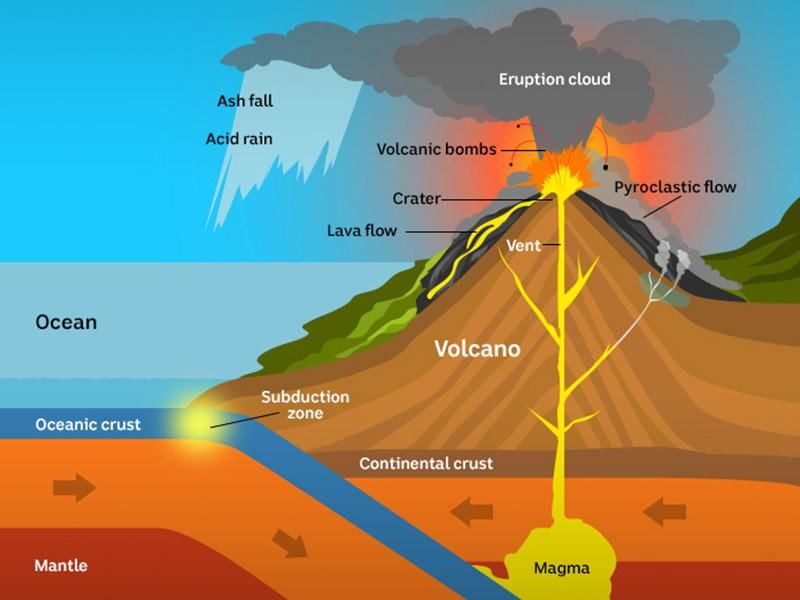Class 7 Exam > Class 7 Notes > Year 7 Physics (Cambridge) > Earthquakes and volcanoes
Earthquakes and volcanoes | Year 7 Physics (Cambridge) - Class 7 PDF Download
Volcanoes
- Description: Volcanoes appear as regular mountains until they erupt, revealing intense forces and high temperatures from the Earth's mantle.
- Magma: Hot, thick molten rock called magma resides in the Earth's mantle. It can rise through chimneys to the surface.
- Eruption: When magma rises, pressure builds up, leading to explosive eruptions. Red-hot magma spews out of the volcano's crater and flows down as lava.
- Impact: Volcanic eruptions showcase the Earth's internal dynamics dramatically.

Earthquakes
- Cause: Earthquakes result from movements of tectonic plates, large pieces of rock that slowly shift.
- Plate Movements: When plates move in opposite directions, they can become stuck, causing immense strain on the rocks.
- Release of Strain: When the strain is released suddenly, earthquakes occur. The point of maximum shaking is the epicenter.
- Impact: Earthquakes can cause widespread destruction in a short time, affecting cities and regions.

Comparing Volcanoes and Earthquakes
- Similarities: Both phenomena reveal the powerful forces within the Earth's crust.
- Differences: Volcanoes release magma and lava during eruptions, while earthquakes result from the sudden release of built-up strain in tectonic plates.
- Examples:
- For volcanoes: Mount Vesuvius eruption in AD 79 buried Pompeii and Herculaneum.
- For earthquakes: The 1906 San Francisco earthquake caused significant damage to the city.
Question for Earthquakes and volcanoesTry yourself: Which of the following is a key difference between volcanoes and earthquakes?View Solution
Conclusion
Volcanoes and earthquakes provide a dramatic glimpse into the Earth's internal workings, showcasing its powerful and sometimes destructive nature.
The document Earthquakes and volcanoes | Year 7 Physics (Cambridge) - Class 7 is a part of the Class 7 Course Year 7 Physics (Cambridge).
All you need of Class 7 at this link: Class 7
|
14 videos|31 docs|9 tests
|
FAQs on Earthquakes and volcanoes - Year 7 Physics (Cambridge) - Class 7
| 1. How are earthquakes and volcanoes related? |  |
Ans. Earthquakes and volcanoes are related because they are both caused by the movement of tectonic plates. Volcanoes often occur at plate boundaries where one plate is subducted beneath another, causing magma to rise to the surface. This movement of magma can also trigger earthquakes as the pressure builds up and is released.
| 2. What are the main differences between earthquakes and volcanoes? |  |
Ans. The main difference between earthquakes and volcanoes is their cause. Earthquakes are caused by the shifting of tectonic plates, while volcanoes are caused by the movement of magma beneath the Earth's surface. Additionally, earthquakes are usually sudden and short-lived, while volcanic eruptions can last for days or even months.
| 3. Can earthquakes trigger volcanic eruptions or vice versa? |  |
Ans. Yes, earthquakes can trigger volcanic eruptions and vice versa. The movement of tectonic plates during an earthquake can cause magma to rise to the surface, leading to a volcanic eruption. Similarly, a volcanic eruption can also cause earthquakes as the pressure from the magma release can create seismic activity.
| 4. How do scientists monitor and predict earthquakes and volcanic eruptions? |  |
Ans. Scientists monitor earthquakes using seismometers to detect seismic waves and track their intensity and location. They also use GPS and satellite data to monitor ground deformation. For volcanic eruptions, scientists monitor changes in gas emissions, ground temperature, and seismic activity to predict when an eruption may occur.
| 5. What are some of the most famous volcanic eruptions and earthquakes in history? |  |
Ans. Some of the most famous volcanic eruptions include the eruption of Mount Vesuvius in 79 AD, which destroyed the Roman city of Pompeii, and the eruption of Krakatoa in 1883, which caused a massive tsunami. Famous earthquakes include the 1906 San Francisco earthquake and the 2011 earthquake and tsunami in Japan.
Related Searches















